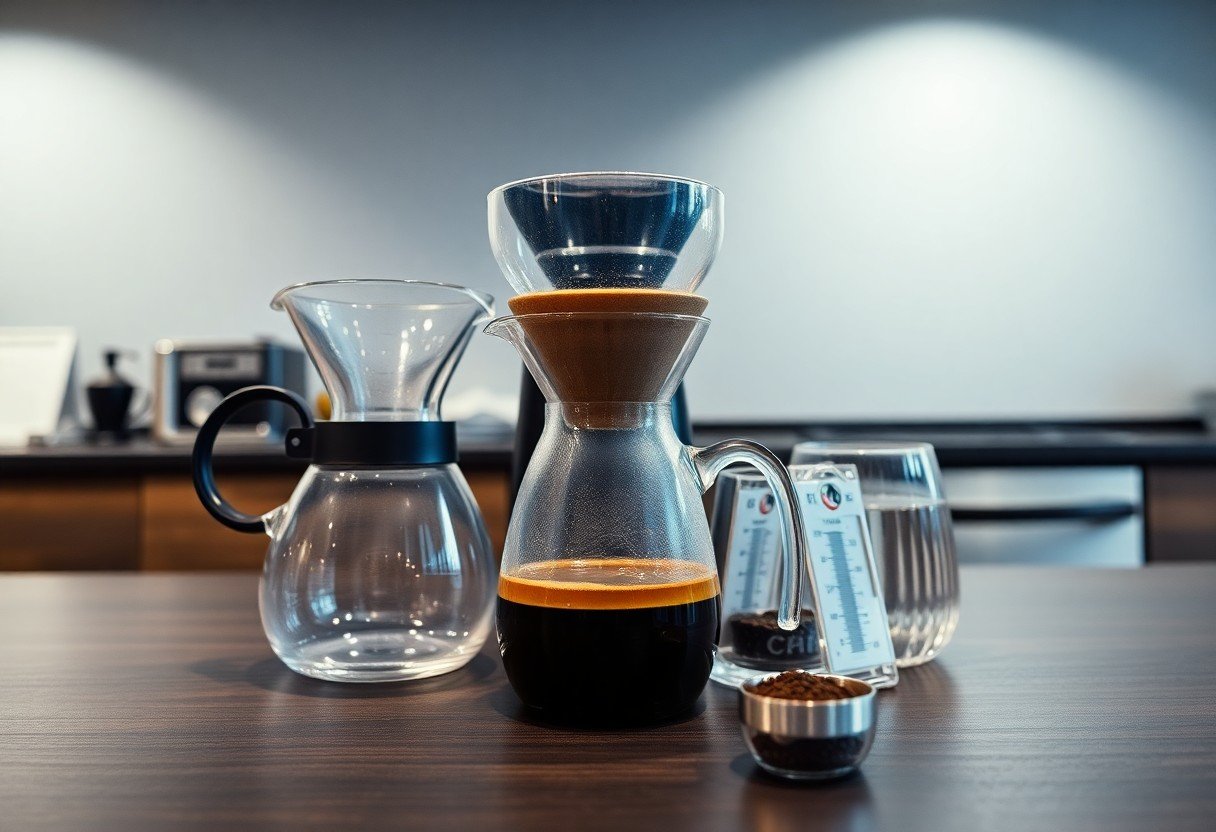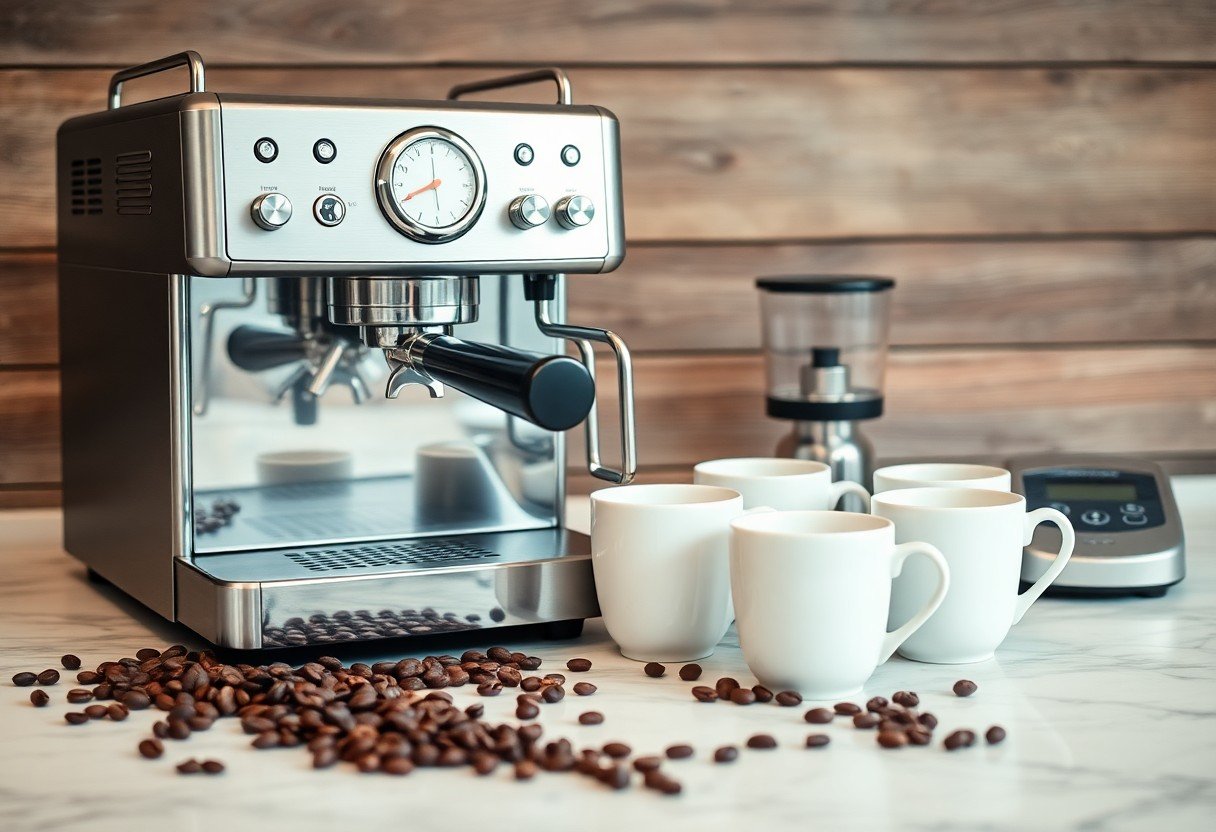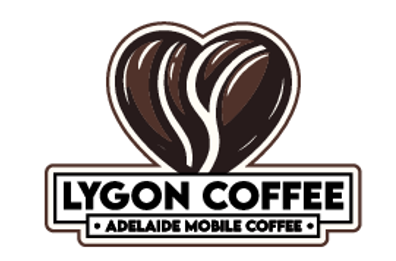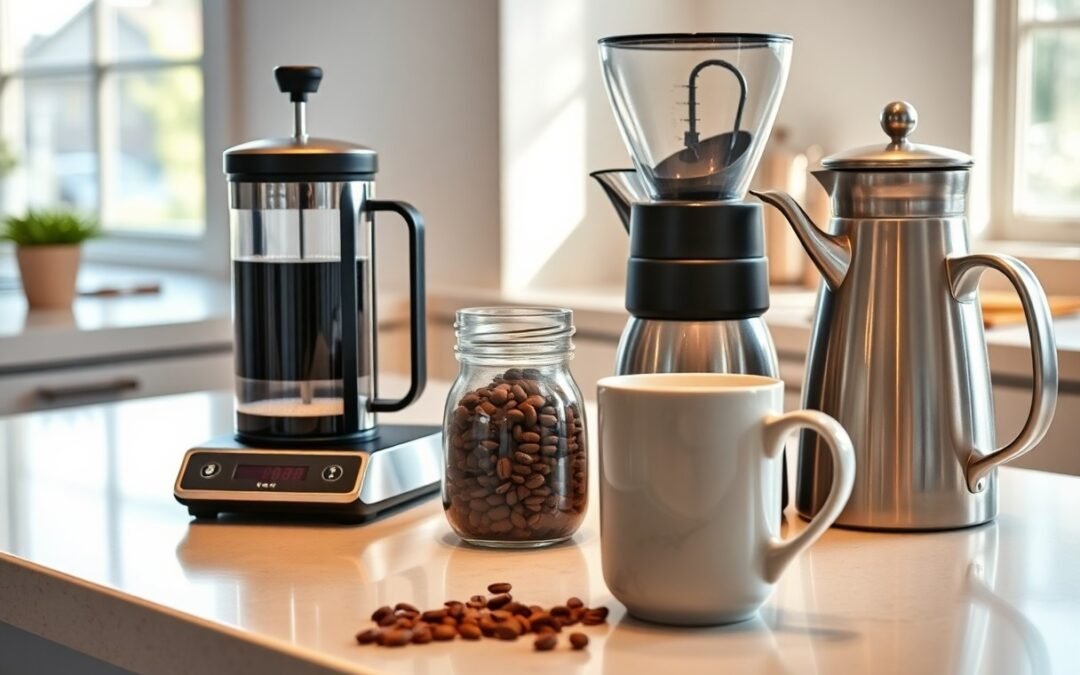Many coffee enthusiasts seek to elevate their brewing experience at home with the right equipment. Investing in specific tools can significantly enhance the flavor and quality of your cup, making each sip a delight. By understanding the imperative devices and gadgets that complement your brewing process, you can transform your kitchen into a barista’s haven, allowing you to enjoy a sophisticated cup tailored to your taste.
Essential Brewing Gear for the Home Barista
Your journey into crafting the perfect cup begins with the right tools. Investing in quality crucials like kettles, scales, and brewers elevates your morning ritual. A good kettle, preferably with temperature control, ensures precise brewing temperatures, while a reliable scale allows for accurate measurements, resulting in consistent flavor profiles. Breville, Hario, and Chemex are brands that provide excellent options, catering to different brewing methods and preferences. Building a versatile toolkit sets the foundation for your coffee mastery at home.
The Versatility of Quality Grinders
Choosing the Perfect Brewing Method: French Press, Pour Over, and Beyond
The Science of Coffee Beans: Selecting Your Best Brew
Understanding the intricacies of coffee beans can significantly enhance your brewing craft. By focusing on factors like bean variety, freshness, and roasting, you can select the perfect beans to complement your taste profile and brewing method.
Understanding Bean Varieties: Arabica vs. Robusta
Arabica beans, known for their delicate flavor and aroma, comprise over 60% of the world’s coffee production, while Robusta beans offer a stronger, bitter profile with higher caffeine content. Your choice between these varieties can dramatically affect your cup, with Arabica providing a sweeter, fruitier experience and Robusta contributing to a richer, bolder brew.
The Impact of Freshness: Roasting Dates and Storage Tips
Freshness determines the vibrancy of your coffee’s flavor. Beans should be consumed within two to four weeks of roasting for optimal taste. Proper storage is vital; keep your beans in an airtight container in a cool, dark place to preserve their freshness.
- Choose beans roasted within the last month.
- Store them in a dark, cool environment.
- Invest in an airtight container.
- Thou must never refrigerate your coffee beans.
To maximize freshness, always check the roast date printed on your coffee bag and prioritize those roasted more recently. Avoid buying in bulk, as exposure to air can quickly diminish flavor. Grind your beans just before brewing to ensure the best extraction of oils and flavors, allowing you to experience every nuance of your chosen brew.
- Grind immediately before brewing.
- Aim to buy only what you’ll use within a few weeks.
- Keep beans away from light and humidity.
- Thou should consider single-origin beans for distinct taste profiles.

Mastering Water Quality for Optimal Flavor
The quality of water significantly influences your coffee’s flavor profile. Using filtered or bottled water can elevate your brew by removing unwanted impurities and enhancing taste. Chlorine and hard minerals can not only affect flavor but also impact extraction, so focusing on your water choice is as vital as selecting high-quality beans.
The Role of Water in Extraction: Beyond Just H2O
Water acts as a solvent in the brewing process, extracting necessary oils and flavors from coffee grounds. The mineral content contributes to the overall taste; for instance, magnesium enhances sweetness, while calcium affects mouthfeel. Balancing these minerals is key in achieving a well-rounded cup that reflects the true character of your coffee beans.
Ideal Water Temperature and Brewing Times
Brewing your coffee at the right temperature and time ensures optimal extraction. The ideal temperature range is between 195°F to 205°F, with brewing times varying based on your method. For example, espresso requires around 25-30 seconds, while French Press needs four minutes to extract full flavor. Paying attention to these details can dramatically improve your brew.
Table: Ideal Water Temperature and Brewing Times
| Brewing Method | Ideal Temperature & Brew Time |
| Espresso | 195°F – 205°F, 25-30 seconds |
| Pour-Over | 195°F – 205°F, 3-4 minutes |
| French Press | 195°F – 205°F, 4 minutes |
| Cold Brew | Room temp or cold water, 12-24 hours |
Brewing times should match the grind size of your coffee. Finer grinds need shorter brewing times as they extract flavors more efficiently, while coarser grounds benefit from longer steeping. Experimenting within the suggested temperature range and times for your chosen method helps you fine-tune your process, leading to a consistently exceptional cup.
Table: Brewing Times by Grind Size
| Grind Size | Recommended Brewing Time |
| Extra Coarse | 4-12 minutes (Cold Brew) |
| Coarse | 4 minutes (French Press) |
| Medium | 3-4 minutes (Pour-Over) |
| Fine | 25-30 seconds (Espresso) |

Elevating Your Coffee Ritual: Techniques and Accessories
To elevate your coffee ritual, refining your techniques and incorporating the right accessories is vital. Mastering the art of coffee brewing involves not just the equipment, but also the skills you develop in the process. Embrace methods like the pour-over or French press, and pay attention to the temperature and timing to bring out the best flavors in your beans. With dedicated practice and the right tools, each cup of coffee you brew at home can become a moment of sophistication.
Skills to Hone: Pouring Techniques and Brew Ratios
Perfecting your pouring technique can enhance extraction and flavor. An ideal brew ratio, typically ranging from 1:15 to 1:18 for coffee to water, will ensure a harmonious balance between strength and taste. Experiment with different pouring methods, such as circular or spiral motions, to control the flow of water and optimize contact with the coffee grounds for the best results.
Accessories That Make a Difference: Scales, Kettles, and Thermometers
Investing in high-quality scales, kettles, and thermometers can drastically improve your brewing consistency. A digital scale, for instance, ensures you use the exact amount of coffee and water every time, while a gooseneck kettle grants precision in pouring, crucial for extraction control. Combining these tools with a thermometer allows you to brew at the optimal temperature, reinforcing the complex flavors in your coffee.
The precision provided by a digital scale is vital for achieving consistency in your brewing process. For instance, a 1:16 coffee-to-water ratio means using 20 grams of coffee with 320 grams of water. A gooseneck kettle not only makes pouring easier but also allows you to achieve a steady, controlled flow that impacts extraction significantly. Thermometers enable you to heat water to the perfect temperature—ideally between 195°F and 205°F—ensuring optimal flavor extraction without bitterness. These accessories, while small, contribute greatly to achieving barista-level brews from the comfort of your home.
Tasting Coffee Like a Connoisseur: Notes and Palate Development
Understanding the complexities of coffee tasting transforms your brewing experience into a sophisticated journey. As you savor different varieties, pay attention to their unique tasting notes—ranging from fruity and floral to nutty and earthy. Developing your palate enhances not only your appreciation but also your ability to identify quality brews. Engaging in regular tastings allows you to discern subtle differences and refine your overall palate, making you a more informed coffee lover.
Developing Your Flavor Profile: Tasting Notes and Terminology
Delve into the language of coffee to boost your tasting skills. Using terms like acidity, body, and balance allows you to articulate your experience effectively. Start identifying specific flavors such as chocolate, citrus, or caramel in each brew. This vocabulary is not just for connoisseurs; incorporating it into your daily coffee routine empowers you to make more informed choices and recognize your preferences over time.
The Art of Cupping: An Interactive Exploration
Cupping is an crucial practice in the coffee world, designed to evaluate aroma and flavor. This method involves specific steps—grinding coffee beans to a coarse consistency, steeping in hot water, and using a spoon to slurp the brew for optimal flavor exposure. Engaging with others in a cupping session also enhances your ability to communicate your impressions and learn from different perspectives.
As you initiate on the cupping experience, aim for a structured approach by participating in group tastings, which can sharpen your palate significantly. You’ll evaluate aromas first, taking note of distinct fragrances that emerge, followed by the first sips to assess acidity and sweetness. Engaging with fellow coffee enthusiasts fosters discussion, where you can explore diverse flavor interpretations, enhancing your own tasting skills. Aim for consistency by using the same coffee varieties to track differences, ultimately honing your ability to discern nuanced flavors and aromas effectively.
Conclusion
Upon reflecting, brewing a sophisticated cup of coffee at home requires the right tools to enhance your experience. By investing in quality equipment like a precision scale, a burr grinder, and a versatile brewing method, you elevate not only the flavor but also the entire process of making coffee. Tailoring your setup to your preferences empowers you to explore various brewing techniques, ultimately enriching your coffee journey. With these vital tools in hand, you can enjoy café-quality brews right from the comfort of your kitchen.
FAQ
Q: What vital tools do I need for brewing coffee at home?
A: Key tools include a quality coffee grinder, a brewing device (like a French press, pour-over, or espresso machine), a scale for precise measurements, a kettle (preferably with temperature control), and fresh coffee beans.
Q: How important is a coffee grinder for brewing?
A: A coffee grinder is vital as it affects the flavor and aroma of the coffee. Burr grinders provide uniform grind size, enhancing the brewing process compared to blade grinders.
Q: What is the best brewing method for home use?
A: The best method depends on personal preference. Popular options include pour-over for clarity of flavor, French press for richness, and espresso machines for concentrated shots, each offering unique tasting experiences.
Q: How can I maintain my coffee equipment?
A: Regular cleaning is important. For grinders, clean the burrs and chamber, for brewing devices, wash with warm soapy water and rinse thoroughly. Descaling kettles and machines helps maintain performance.
Q: What type of coffee beans should I use for a sophisticated brew?
A: Opt for high-quality, freshly roasted beans. Explore single-origin varieties for distinct flavors, or blends for balanced taste profiles. Experiment with different roast levels to find your preference.

